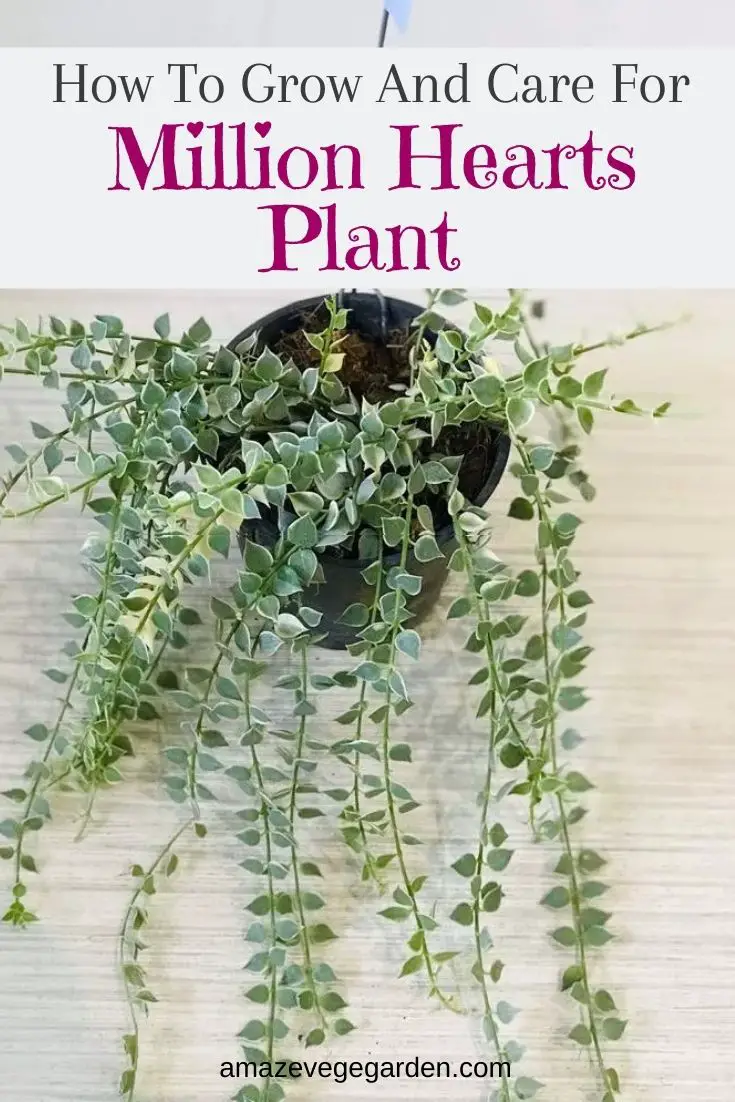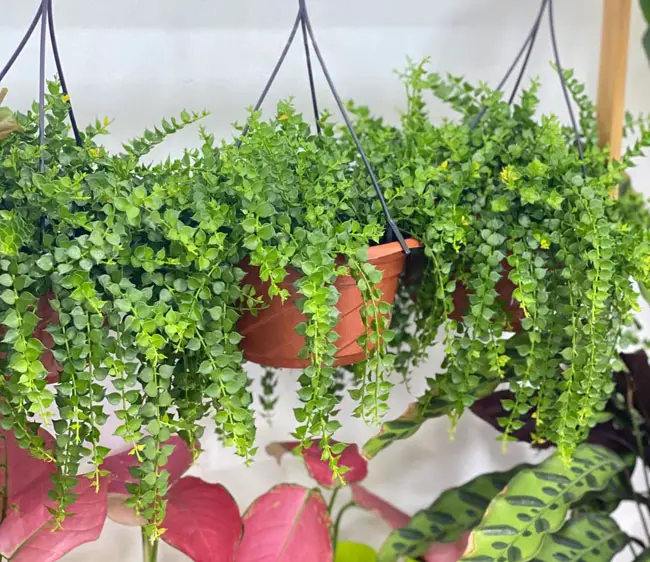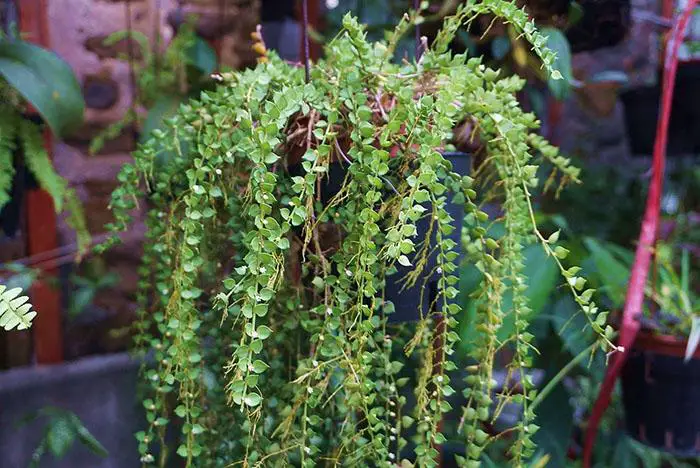Dischidia ruscifolia or the million hearts plant is one of the best decorative plants you can have indoors if you are looking to beautify your home with the gorgeous appeal that comes with household plants. When placed in a hanging pot, the million hearts plant will only become more appealing than it already is. So, how do you grow and care for the million hearts plant if you want to decorate your home with one?
The million hearts plant should only be watered when the soil is completely dry. However, make sure that you keep the plant in a humid area by misting it almost every day or placing its pot in a saucer with water. And, in terms of light, keep it in an indoor area with a lot of indirect sunlight.
Taking care of a great houseplant such as Dischidia Ruscifolia shouldn’t be much of a problem, even for a beginner plant enthusiast. However, just because this isn’t a tough plant to take care of doesn’t necessarily mean that you can wing it when taking care of the plant. You still need to know more about properly taking care of the million hearts plant so that it will thrive under you.
Caring for the Million Hearts Plant (Dischidia ruscifolia) can be a rewarding experience. With its unique heart-shaped leaves, it’s sure to bring joy and beauty into any space. But if you’re not careful, this delicate plant could suffer from poor health or even die. As an experienced horticultural expert and devoted plant care specialist, I’m here to help you make sure your Dischidia remains healthy and thriving. In this article, we’ll go over all the essential steps of caring for a Million Hearts Plant so that you can enjoy its beauty for years to come.
As with many other houseplants, providing adequate light is one of the most important aspects of keeping your Dischidia alive and well. These plants prefer bright indirect sunlight or partial shade throughout the day; too much direct sunlight will scorch their leaves while too little will cause them to become leggy and weak. Additionally, they need regular watering in order to stay properly hydrated – water when the top inch or two of soil feels dry to keep your plant happy.
Finally, proper fertilization is key for promoting strong growth and encouraging blooms during springtime. A balanced fertilizer should be applied at least once every month during the growing season but never during winter months when they are dormant – otherwise, you risk harming the roots due to excessive nitrogen levels in the soil. By following these three basic steps – providing enough light, regular watering, and correct fertilizing – your Million Hearts Plant will thrive happily indoors year-round.
Soil Requirements
Beautiful, vibrant, and resilient; the million hearts plant is a stunning addition to any home. But for it to flourish, there are certain soil requirements that must be met.
Firstly, these epiphytic tropical species require a well-draining potting mix with an acidic pH between 4.5 and 6.0. Additionally, these plants should not be placed in garden beds or soil which contains too much clay as their roots may become waterlogged and rot away quickly. To achieve optimal drainage you can add some perlite or coarse sand into your standard potting media when planting.
Secondly, the million hearts plant does best in soils rich in organic matter such as composted bark mulch or peat moss – both of which aid in retaining moisture while providing essential nutrients needed for growth and health. You should also avoid using fertilizers that contain high levels of nitrogen as they will cause the leaves to yellow over time.
Finally, ensure your pots have adequate drainage holes at the bottom to allow excess water to escape from the roots of this succulent variety so it doesn’t sit stagnant inside its container – otherwise, root rot could occur if left unattended.
Light And Temperature Requirements
Caring for the million hearts plant, or Dischidia ruscifolia, is an enjoyable endeavor. It thrives in bright indirect light and prefers a warm temperature range between 65°F (18°C) and 85°F (29°C). For optimal growth it’s best to keep your million hearts above 68°F (20°C), however, cooler temperatures are tolerated as long as they don’t dip below 50°F (10°C). If this occurs, some leaf drops may occur but the plant should still be okay. Avoid placing your million hearts in direct sunlight because their leaves can burn easily.
The more warmth and light you provide, the better your plant will do; so if possible put it near a south-facing window that receives several hours of sunlight each day. This type of environment also helps with humidity levels which is ideal for growing healthy plants.
Besides needing adequate moisture around its roots, the million hearts need high relative humidity of about 60% – 80%. To maintain these conditions consider misting once or twice a week or using a pebble tray filled with water beneath the pot.
Watering Requirements
The Million Hearts plant is tolerant of low humidity and dry soils, but it still needs regular watering. Water when the top inch or two of soil is dry; this typically means once per week in summer months and every other week in winter months. It’s important to avoid overwatering, as too much moisture can cause root rot. To ensure your plant gets enough water without being overwatered, use a moisture meter if you have one available.
It’s also important to make sure your pot has adequate drainage holes so excess water can escape easily. If there isn’t good drainage, keep an eye on how much water you’re adding and be aware that the soil may stay wet for longer than usual before drying out.
Take care not to let the plant sit in standing water after watering – empty any excess from its saucer or tray promptly.
Fertilizing Recommendations
Fertilizing million hearts plant is a key component of their care. To ensure healthy growth and blooming, they need regular feeding with an all-purpose fertilizer containing balanced levels of nitrogen, phosphorus, and potassium. It’s recommended to apply the fertilizer monthly throughout the growing season – usually March through October in most regions.
If you’re using liquid fertilizers, dilute them at half strength before applying it directly to the soil or by foliar spraying. For solid fertilizers such as pellets or granules, spread evenly around each plant and work into the top layer of soil. Take extra caution when spreading these products on humid days since too much can burn foliage if not rinsed off quickly.
It’s important to be mindful of how often you feed your Dischidia Ruscifolia because overfertilizing can damage their root system. Every other month should suffice for mature specimens but younger plants may require more frequent doses – especially during springtime when temperatures are milder and new shoots begin emerging from dormancy.
How Do YOu Take Care of a Million Hearts Plant?
The first thing you need to know more about the million hearts plant if you are taking care of it is that it doesn’t need to be watered regularly. That’s because this plant is used to living in areas that lack water and are more likely to get water from the moisture in the air.
As such, you should only water the million hearts plant whenever its soil is completely dry, as overwatering this plant can lead to health problems caused by molds and fungi.
Also, because Dischidia Ruscifolia prefers to get its water from the moisture in the surrounding air, it thrives in quite humid areas. To provide the humidity it needs, make sure that there is a nearby water source such as a shallow bin of water under the million hearts plant’s pot.
But if you can, you may mist the Dischidia Ruscifolia daily with a water spray but make sure that you do not overdo it because you need to make sure that the plant’s soil is completely dry before you water it again.
You must allow the Dischidia Ruscifolia to stay in well-draining soil because you don’t want the water in the soil to linger on.
In that case, you should make the soil as loose as possible while also using a pot that has effective draining holes. But place a tray under the pot to catch the water. The tray will also serve to keep the humidity levels around the million hearts plant high enough.
When it comes to the sunlight it needs, it is best to keep the million hearts plant close to indirect sunlight all day long, such as by placing it near the window. It thrives when it takes in indirect sunlight, but it may not do well when exposed to direct sunlight when placed outdoors. Make sure that you keep exposed to indirect sunlight only.
Dischidia Ruscifolia is a very hardy and resilient plant. That’s why it is very easy to take care of beginners taking care of their first houseplants.
Pruning Techniques
Pruning is an important part of caring for the Million Hearts Plant (Dischidia Ruscifolia). Pruning helps to maintain the shape and health of this plant. It should be done carefully, with proper tools and techniques in order to prevent any damage. Here are some tips on pruning your Million Hearts Plant:
- Use sharp, clean shears or scissors when cutting off dead leaves or stems.
- Make sure to cut back only what needs to be removed and avoid over-pruning.
- Trim away sickly-looking leaves that may have been infected by pests or diseases.
- Avoid trimming too close to the main stem as this can cause harm to the plant’s growth system.
- Prune above a leaf node so that new branches will form at that point after pruning.
This type of careful maintenance will ensure that your Million Hearts Plant stays healthy and grows vigorously throughout its lifespan.
Potting And Repotting Tips
Million Hearts plants thrive in well-draining soil, and their potting mix should be light and airy. A good starting point is to use a commercial cacti or succulent potting mixture with the addition of organic matter like compost or peat moss. Repot your Million Hearts every two years using fresh soil as needed.
When repotting, make sure that you don’t disturb its roots too much: instead, remove just enough soil to give it some room to grow without changing its shape drastically. If you’re transplanting into a larger container, add new soil at the bottom and sides before adding your plant back in. After replanting, water thoroughly and then wait until the top inch of the soil has dried out before watering again.
Signs Of Disease Or Pests
Diseases or pests can cause dischidia ruscifolia, a million heart plant, to become unhealthy. It’s essential to check for signs of disease and/or infestation regularly. With quick action and timely intervention, you can prevent the spread of any potential sicknesses your million hearts might develop.
First, examine the leaves for white spots or yellowing that could indicate fungal infections like powdery mildew. If you spot these areas on the leaves, prune away the affected parts immediately then treat them with an anti-fungal spray. Additionally, inspect both sides of the leaves for small insects such as aphids or mealybugs; they may appear in clusters and leave behind honeydew when disturbed. To get rid of these pests, use a pesticide following directions carefully.
Next, look closely at stems and soil around them for fungus gnats which are dark tiny flies hovering over wet surfaces. These thrips feed off bacteria found in moist soils so it is important to keep your potting mix dry by allowing it to drain completely between waterings and avoid overwatering altogether. Furthermore, be mindful of how much fertilizer you apply because too much nitrogen causes luxuriant growth that weakens plants’ defenses against diseases and predators alike.
In short, regular inspections along with proper care will help maintain healthy million hearts plants free from illnesses or parasites.
Is Million Hearts Plant a Succulent?
While the million hearts plant does not look like your usual succulents such as cacti and any other succulents that you commonly see in most gardens, it still is classified as succulent for various reasons.
First off, succulents are plants that are quite thick. The Dischidia Ruscifolia actually has thick leaves that are succulent in nature. And the second reason is that, like most succulents, it has evolved and has adapted to harsh conditions where the weather is quite hot and there is little water available in the area.
As such, it can retain water in its body as most succulents can so that it gets to preserve whatever water it can get.
Like any succulent, the million hearts plant is great at storing water in any part of its body, such as its leaves. That’s why most succulents have thickened leaves that they use to store water or as a means to adapt to the harsh and warm environment they live in.
How Quickly Do Million Hearts Grow?
If you are propagating the million hearts plant from clones, you will find that it will quickly grow roots from the cuttings from the mother plant in a matter of a few weeks. There is no certainty as to how quickly this plant can grow, but you can be sure that it actually grows quicker than most other succulents, particularly because it is great at drawing moisture from the air for water and nutrients.
How Often Should I Water Dischidia?
When watering the Dischidia Ruscifolia, you should keep in mind that this plant effectively draws moisture from the air for its water and does not need to be watered regularly, unlike most other plants that rely solely on the water they get from the soil using their roots.
As such, the rule of thumb when it comes to the million hearts plant is that it should be similar to most other succulents in the sense that you need to make sure that the soil is completely dry before you water it again.
If you overwater it or water the soil without waiting for it to dry out, you may open the million hearts of plants to diseases caused by molds and fungi. That’s why you need to make sure that you wait for the soil to dry out before watering it again completely.
In most cases, you may have to wait about two to three weeks before the soil completely dries out. This can shorten to a week or so during the summer when the weather gets too warm. During the winter, however, you probably need to water it once every three or so weeks due to how the water in the soil will take a while to evaporate.
The Dischidia Ruscifolia is very tolerant to droughts considering that it has evolved in places that are prone to droughts. That’s why you shouldn’t worry about allowing its soil to dry out completely before you water the soil once again.
How Much Sun Does Million Hearts Need?
Like most succulents, the million hearts plant needs a lot of sun to survive because it gets most of its nutrients from the sun. Of course, you also have to consider that succulents are used to getting exposed to the sun because most of them live in harsh and warm environments.
However, in the case of the million hearts plant, you should keep it out of direct sunlight by keeping it indoors. It might be best to place it near a window to get all the sun it needs without getting exposed to the sunlight directly. Dischidia Ruscifolia thrives better in indirect sunlight.
But if you opt to keep it outdoors, do not expose it to the sun directly. Try to keep it somewhere that is lightly shaded so that it won’t get exposed to sunlight openly. You may want to keep it close to taller plants in that regard.
Also, for those keeping it indoors, allow it to get exposed to indirect sunlight for as long as possible. It needs about 12 hours of sunlight daily. But if you are using artificial lights, make sure that you keep it exposed to the lights for about 10 to 12 hours a day.
How Do You Propagate a Million Hearts Plant?
For those who are looking to propagate the million hearts plant, here is how you can do so:
- Use clean and sharp scissors or a nice sharp blade to quickly and cleanly cut off the bottom leaves from the plant’s stem. Be careful not to get exposed to the white substance released by the million hearts plant because it may irritate your skin.
- Always wash your hands before and after handling the plant to ensure that neither you nor the Dischidia Ruscifolia can get infected.
- Place the cuttings in a vase or a glass of water.
- Wait for a few weeks for the roots from the cuttings to form.
- After the roots had already formed, you can place the million hearts plant in a separate container or pot.
- When potting the Dischidia Ruscifolia, you should place it in a pot with loose soil because it allows air to circulate better. Again, the million hearts plant likes to get its water from the moisture in the air. Loose soil will allow more air to circulate near its roots, thereby getting water from the air.
Also read: How to Take Good Care of Monkey’s Tail Cactus.
Did you find this post useful? Would you like to get back to it later? Save THIS PIN below to your garden, cacti, houseplant, cactus, and succulents boards on Pinterest! Thanks 🙂



